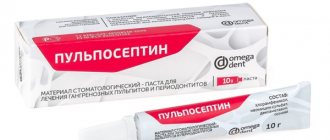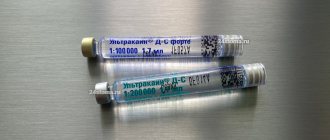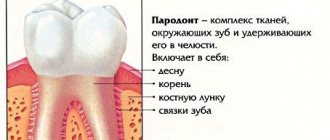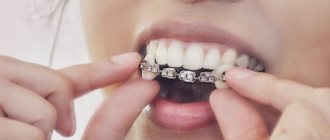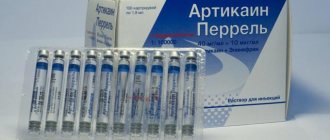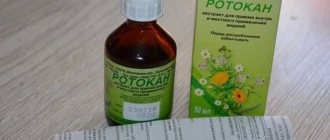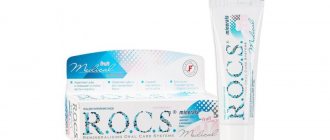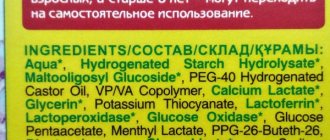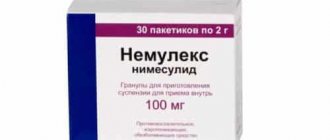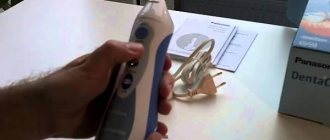Since childhood, people have been afraid of visiting the dental office and try to avoid such an event.
Modern dentistry has the ability to minimize the discomfort that creates fear with the help of specially developed painkillers.
Ultracain is considered one of these. The product reduces the pain inherent in the dental treatment process.
Drug review
Ultracaine is a transparent and colorless substance of a local anesthetic drug, odorless. The active ingredient is Articaine. Pharmaceutical companies produce the product in ampoules of 5 ml and 20 ml. The cardboard package contains 5 ampoules.
In dentistry, the substance is used as a local anesthetic. The injection can prevent the passage of impulses into nerve cells and prevent the occurrence of pain.
Storage conditions
The solution should be stored at an ambient temperature not exceeding 25°C , away from direct sunlight. The shelf life of the drug in ampoules ranges from 30 months to 5 years , in cartridges 3 years .
At home
Although it is not advisable to store the drug at home, it is possible to ensure its proper safety if you follow some recommendations.
Preferred places to store Ultracaine at home:
- A home first aid kit, which should be kept out of the reach of children.
- Special compartment for medicines in the refrigerator.
- Places not exposed to sunlight and aggressive mechanical influences.
Where it is prohibited to store the drug:
- In the freezer compartment of the refrigerator.
- Near sources of open fire and near heating devices.
Strong heating of ampoules with medicine is strictly prohibited. This could cause them to explode and cause injury to people nearby.
In medical settings
Medical institutions, such as pharmacies, clinics and paramedic stations, are best suited for storing Ultracaine. The obligation to ensure proper safety of the drug is provided for by departmental regulations.
Among other things, it is prescribed that the medicine should be kept in cabinets and containers that are impenetrable to light . The procedure for disposing of a drug that has become unusable has been determined. This is carried out by authorized persons at sites allocated for these purposes, using special equipment.
Storage of Ultracaine during transportation is determined by GOST 17768-90 . In accordance with this state standard, cartridges and ampoules are placed in plastic containers. Then they are packaged in cardboard boxes, which come with instructions.
Composition and characteristics
1 ml. the solution contains articaine hydrochloride (4%) and epinephrine (adrenaline hydrogen tartrate). Articaine is a 5th generation analgesic that combines strong pain relief and safety for the patient’s health.
According to research, the effect of Articaine is two times stronger than the effect of Lidocaine. The drug has a high distribution rate.
Characteristics of the drug
| start of action | 3 minutes after injection |
| duration of action | 45 min. – 1.5 hours |
| withdrawal time | from 5 to 10 hours |
| protein binding | 95% |
| recommended quantity | 1.7 mg/tooth |
| For adults | maximum 7mg/kg |
| children | maximum 5mg/kg |
| pregnant women | maximum 1.7 mg/tooth |
| metabolism | in the liver |
Analogs
Level 4 ATX code matches:
Markain
Scandonest
Emla
Naropin
Versatis
Lidocaine
Ubistezin
Ultracaine D-S Forte
Ultracaine D-S
Artikain
In terms of active ingredients, analogues of Ultracaine are Ubistezin Forte , Articaine , Artifrin , Primacaine with adrenaline , Cytokartin and Septanest with adrenaline , Articaine with adrenaline .
One drug group includes the drugs Lycaine , Marcaine , Lidocaine , Scandonest , etc.
Which is better: Ultracaine or Lidocaine?
The drug Lidocaine is also used for anesthesia during dental procedures. It rarely causes allergic reactions, although it has a number of contraindications. However, Ultracaine is a less toxic agent that allows for more durable anesthesia.
Pharmacology offers
In dental practice, three types of the drug are used, differing in composition, properties and purpose.
Ultracain DS
Ultracain DS is produced in a cardboard box containing either:
- 100 carpules of 1.7 ml;
- 10 ampoules of 2 ml.
The anesthetic should be used with caution, since injection of the solution may cause allergies or other side effects.
Before use, it is necessary to find out the presence of all existing diseases and perform a preliminary test before administering the full dose.
After using Ultracain DS in pediatric dentistry, it is necessary to warn parents about possible independent damage to the soft tissues of the oral cavity.
A similar phenomenon occurs due to decreased tissue sensitivity over a long period of time.
The substance is prescribed for tooth extraction, orthodontic treatment, or during measures before prosthetics.
Ultracaine DS forte
It differs from Ultracaine DS in the increased content of epiniphrine hydrochloride (0.012 mg). It takes 2-3 minutes for the drug to take effect.
Typically, the effective action of the injection lasts for 60-75 minutes. A side effect may occur, and therefore the dentist needs to perform tests and identify possible health problems in the patient.
Ultracain D
This type of drug includes:
- articaine hydrochloride - 40 mg;
- sodium chloride - 2 mg;
- purified water.
It has a local anesthetic effect during dental treatment or removal.
A special feature is the absence of adrenaline in the composition, which allows the drug to be used even for patients with certain contraindications.
However, the solution lasts only 20 minutes. Moreover, the solution is non-toxic. The maximum dosage is not more than 40 mg. The product is contraindicated for use in children under 4 years of age.
Ampoule with medicine in a ratio of 1:200000
The drug is called Ultracaine DS . The difference from the previous option is the concentration of epinephrine in the solution. If Ultracaine DS Forte contains 12 mcg , then in this case its addition is halved . It contains 6 mcg . This allows you to avoid negative consequences for the cardiovascular system and surges in blood pressure. The latent period remains the same, but the duration of action of the injected anesthetic is reduced. A decrease in the amount of epinephrine does not mean that the painkiller can be used for thyroid pathologies. For this purpose, Ultracaine D is allowed, which does not contain synthetic adrenaline.
Indications and contraindications
The drug is used as an anesthetic substance for certain areas of the oral cavity during the following dental procedures:
- local anesthesia before treatment of a tooth affected by caries;
- administration of the product before extraction;
- during grinding of a tooth intended for prosthetics.
Dentists do not recommend using Ultracain in the following cases:
- personal intolerance to the components of the solution;
- children under four years of age;
- tachycardia;
- bradycardia;
- heart failure;
- anemia;
- hypoxia;
- with manifestations of bronchial asthma;
- severe symptoms of arterial hypotension;
- hyperthyroidism;
- myocardial infarction.
Classification of non-carious dental lesions and treatment methods depending on the clinical picture. Come here to become more familiar with the technique of application anesthesia in dentistry.
At this address https://dentist-pro.ru/lechenie/zuby/infiltracionnoj-anestezii-v-stomatologii.html read what drugs are used in dentistry for infiltration anesthesia.
Types of anesthesia before tooth extraction
In most cases, local anesthesia is sufficient for any dental procedures. Typically, this is one or more injections into the gums. Some clinics perform three-stage anesthesia, which completely eliminates pain. In this case, an anesthetic gel is first applied, then a short injection is given, and after some time a sufficient dose of anesthetic is administered. Sometimes it also becomes necessary to perform a similar operation under general anesthesia. What anesthesia for tooth extraction is required in each specific case is determined by the doctor in accordance with individual characteristics.
Most often, local anesthesia is sufficient. Such anesthesia relieves the patient 100% of pain. Only tactile sensitivity is preserved, which can also cause discomfort, but not severe. There are several types of local anesthesia.
- Application anesthesia relieves pain only with superficial intervention. It is usually used before an injection to make insertion of the needle painless. Sometimes it is indicated when removing baby teeth in children. This anesthesia is carried out using a gel or spray based on lidocaine or benzocaine. They are applied to the gums.
- Infiltration anesthesia is the most common method. In this case, pain relief during tooth extraction is administered by injection. Usually you need 2-3 injections on one side and the other of the diseased tooth.
- Conduction anesthesia involves injecting an anesthetic into the area of the nerve. After this, the entire area innervated by it loses sensitivity. It is usually used only on the lower jaw.
- Trunk anesthesia is used in serious cases or when the patient is hypersensitive. In this case, the medicine is injected into the base of the skull.
In addition, sometimes a method such as sedation is also used. This is the administration of intramuscular or intravenous sedatives. They calm the patient, increase the pain threshold, and relax.
Features of use
The amount of drug administered is calculated taking into account the body weight and age of the patient. It is also important to take into account the individual characteristics of the body.
Basic recommendations for use:
- The optimal dose is 1.7 ml. In the absence of pathologies and the patient’s health characteristics, this volume should be sufficient to treat one tooth. If the effect is not achieved, the same amount is administered. If sensitivity is still present, then it is better to refuse this injection. In such a case, a complete blockade of the jaw is performed using analog drugs.
- Before operating on the tooth under the crown, a solution in a volume of 1 ml is injected.
- For the procedure of dissection and suturing of the palate and gums, the injection of 0.1 ml will be sufficient. substances.
- If it is necessary to increase the dose, the doctor should remember that the maximum volume should not exceed 7 ml/1 kg of the patient’s weight.
- The effect of the drug on children under 4 years of age has not been studied, and therefore it is better not to use the drug on children in this age group.
It is acceptable to use the substance for dental interventions in the oral cavity of pregnant and lactating women.
Absorption of the solution into the placenta is minimal compared to other anesthetics and does not pose a serious danger. The substance does not affect the process of breastfeeding and the quality of milk, since it does not penetrate into milk.
Reviews about pain relief in dentistry
Nowadays dental treatment has become much more comfortable than before. Pain is usually not felt even when removed. At the same time, many patients note that they received effective pain relief with the help of regular Lidocaine. But there are also those who cannot tolerate this drug. And those who have been injected with modern anesthetics note that they have a better analgesic effect. There are many positive reviews about the drug "Ultracain", patients note that they do not feel anything even during a complex operation.
Category: Tooth extraction Published by Mister stomatolog
Precautionary measures
The treating dentist must remember to take certain precautions:
- Ultracaine solution is administered exclusively intramuscularly; intravenous administration is strictly prohibited.
- Use is not recommended if the patient has cholinesterase deficiency. Otherwise, the effect of the injection may last longer than the specified period.
- Ultracaine is not injected into inflamed areas of the oral cavity.
- The drug is collected using new instruments. Reusing syringes is unacceptable.
- Cartridges must be carefully checked for integrity and serviceability.
- Before the injection, the doctor warns the patient about possible difficulties in driving under the influence of the drug.
Let's figure out whether it is possible to take a dental x-ray during pregnancy, and how dangerous it is for the expectant mother and fetus. In this article we will try to explain why teeth hurt more at night.
Here https://dentist-pro.ru/lechenie/zuby/v-chem-prichiny-razrusheniya-i-podlezhat-li-oni-vosstanovleniyu.html common causes of rapid tooth decay are listed.
Ultracaine price, where to buy
The price of Ultracaine depends on the form of its release and the type of product. You can buy Ultracain D-S (10 ampoules) for an average of 550 rubles. The price of 1 ampoule of Ultracain D-S Forte is on average 50 rubles. How much the product costs in other forms of packaging can be found at the specific point of sale.
- Online pharmacies in RussiaRussia
- Online pharmacies in UkraineUkraine
ZdravCity
- Ultracaine D-S solution d/in.
(with epinephrine) 40 mg+0.005 mg/ml amp. 2ml No. 10Sanofi-Winthrop Industrie/Delpharm Dijon RUB 1,379 order - Ultracaine D-S solution d/in. (with epinephrine) 40 mg+0.005 mg/ml cartridges 1.7 ml No. 100 Sanofi-Aventis Deutschland GmbH / Sanofi Winthrop Industry
6400 rub. order
- Ultracaine D-S forte solution for injection. 1.7 ml 100 pcs. Sanofi-Aventis Deutschland GmbH / Sanofi Winthrop Industry
RUR 6,443 order
- Ultracaine D-S forte solution for injection. 2ml 10 pcs. Sanofi-Aventis Deutschland GmbH/Delpharm Dijon France
RUB 1,450 order
Pharmacy Dialogue
- Ultracaine D-S Forte ampoules 2ml No. 10Sanofi-Winthrop Industrie
RUB 1,355 order
- Ultracaine D-S ampoules 2ml No. 10Sanofi-Winthrop Industrie
RUB 1,318 order
- Ultracain D-S (cart. 1.7 ml No. 100)Sanofi-Aventis
RUR 6,286 order
- Ultracaine D-S (amp. 2 ml No. 10) Delpharm Dijon
RUB 1,326 order
show more
Pharmacy24
- Ultracaine D-S forte cartridge 1.7 ml No. 100 solution Sanofi-Aventis Deutschland GmbH, Germany/Sanofi Winthrop Industries, France
2214 UAH.order
Side effects and overdose
Side effects from the drug most often occur within 5-70 minutes after administration. The following phenomena are possible:
- If exposed to the digestive tract , nausea and vomiting are likely to occur.
- The central nervous system may respond with seizures, blurred vision or fainting, tremors, dizziness, temporary blurred vision, or complete loss of vision.
- Allergic reactions manifest themselves in the form of rashes, such as urticaria, exacerbation of rhinitis, skin hyperemia, swelling of both individual parts and the entire face, difficulty breathing. Any of these symptoms can cause anaphylactic shock.
- Symptoms of effects on cardiac activity can be a sharp decrease in blood pressure, bradycardia, tachycardia, and heart failure.
In case of overdose, the following symptoms occur:
- Motor stupor, or, conversely, excitement;
- Nausea and dizziness;
- Decreased blood pressure;
- Convulsions;
- Labored breathing;
- Bradycardia;
- Anaphylactic shock;
- Swelling of the airways;
- Skin allergic manifestations.
Interaction
With the simultaneous use of tricyclic antidepressants and MAO inhibitors, an increase in the hypertensive effect of the drug is observed.
When taking vasoconstrictor drugs, the local anesthetic effect of articaine .
With simultaneous treatment with non-selective beta-blockers, bradycardia and hypertensive crisis increases .
Under the influence of Ultracaine, the influence of other local analgesics increases, and as a result, depression of the nervous system is noted.
Analogues and interactions with other drugs
Before using Ultracaine, you should inform the attending physician about the medications the patient is taking at this stage.
Interactions with the following drugs are dangerous:
- Monoamine oxidase inhibitors;
- Antidiabetic medications;
- Types of inhalation anesthesia;
- Norepinephrine and adrenaline;
- Antithrombotic agents;
- Tricyclic antidepressants;
- Non-selective beta-adrenergic blockers.
| analogue | difference | Packaging price |
| Ecocaine | Contains adrenaline in various dosages, used when long-term surgical intervention is necessary | From 900 |
| Cytokartin | Used for intense ischemia and deep dental interventions | From 1000 |
| Ubistezin | Used for minor operations in the oral cavity | From 1 415 |
| Scandonest | Indicated when it is impossible to administer a vasoconstrictor | From 450 |
| Septanest with adrenaline | Begins to act in 2-3 minutes. after administration, anesthesia lasts 40-60 minutes. contains 0.015 adrenaline tartrate, contains a considerable amount of preservatives | From 2 595 |
| Mepivastezin | Used for patients with bronchial asthma, diabetes and allergies to adrenaline | From 1267 |
| Lidocaine | The spray can be used for children over 2 years old. Also available in powder and injection form. Active ingredient: lidocaine hydrochloride | From 17 |
| Brilocaine-adrenaline | Contains less adrenaline | From 1200 |
| Artifrin | Administered intravenously, the composition of the auxiliary elements differs slightly from the composition of ultracaine | From 1350 |
| Artikain | For use in dentistry only | From 238 |
The video provides additional information on the topic of the article.
Indications for use
The drug is indicated for use for infiltration and conduction anesthesia during operations and diagnostic interventions to relieve pain.
Ultracaine in dentistry is prescribed for a variety of procedures, including filling and extraction of teeth, during the installation of crowns, during preventive procedures, and treatment of wounds. Administration is also practiced during surgical interventions performed in the nasopharynx.
Which ultracaine is stronger, blue or green?
This review uses the questions most frequently asked on dental forums on the Internet.
Is it necessary to carry out an aspiration test when working with Ultracain?
An aspiration test is mandatory when working with any anesthetic to prevent the introduction of the drug into the vascular bed. It is necessary to carry out a slight reverse movement of the piston of the carpule syringe. Any amount of blood in the carpule means a positive aspiration test. Therefore, the anesthetic cannot be injected and the position of the needle must be changed. Unfortunately, not all drug carpules have a convenient device for performing an aspiration test.
Tell me, what “Ultracaine” should be used to remove the nerve?
For depulpation, we recommend using the drug “Ultracain D-S forte” if the patient is not included in the anesthetic risk group. The anesthetic risk group includes pregnant women, people over 55 years of age, and people with concomitant cardiovascular and endocrine pathologies.
Does Ultracain have a device for performing an aspiration test?
The Ultracaine carpul piston, unlike the carpules of other drugs, has a special device for conducting an aspiration test. Ultracain carpules are well suited to the types of carpule syringes used, and the structure of their piston with a special hole for aspiration makes it easy to carry out this test.
What can happen when Ultracaine is injected into the vascular bed?
Intravascular administration of the drug is an extremely unpleasant complication, as it is associated with a number of consequences. In addition to the direct toxic effect of any local anesthetic and vasoconstrictor on the cardiovascular and nervous systems, intravascular administration may be accompanied by bleeding and hematoma.
What forms of Ultracaine are there?
The company “Aventis Pharma” produces two forms of the drug: “Ultracaine” D-S” and “Ultracaine D-S forte”, and the inscriptions on the carpules and packaging of the drug are applied in different colors depending on the content of the vasoconstrictor. For example, carpules of “Ultracaine D-S” with an adrenaline concentration of 1:200,000 are green, and “Ultracaine D-S forte” with an adrenaline concentration of 1:100,000 are blue.
What explains the higher price of Ultracain in comparison with competitive drugs of the same group?
"Ultracaine" was created (Germany), which, merging in 1999 with (France), formed a pharmaceutical company. It was here that articaine was first synthesized. "Ultracaine" is an original drug. The results of all studies on articaine-containing anesthetics were obtained using Ultracaine. continues to invest in studying the drug. The company sponsors the work of scientists in the field of pain management. Research into new possibilities and methods of using articaine led to the development of a new type of “Ultracaine”, which does not contain adrenaline, successfully used in clinics in Western Europe, which will appear on our market in the coming years. One can also say about the high quality control of products in.
Does Ultracain contain parabens and EDTA?
The original drug "Ultracain" does not contain vasoconstrictor preservatives - parabens and EDTA - thanks to the special technology for the production of high-quality glass and rubber parts of carpules. It is known that the main cases of allergy to the anesthetic are allergy to the vasoconstrictor preservative. "Ultracaine" contains sodium metabisulfite, which promotes the stability of the vasoconstrictor, in the lowest concentration.
Is an allergy to Ultracaine common?
When using local anesthetics, the allergen may be the anesthetic itself (for example, novocaine), but more often the allergy is caused by preservatives (especially parabens), antioxidants, buffers and other additives contained in the solution. When choosing an anesthetic dosage form, preference should be given to drugs that do not contain paraben, an antibacterial and antifungal preservative that most often causes allergic reactions. In the Ultracaine solution, the content of an antioxidant - a substance that prevents the oxidation of adrenaline - is minimal (the metabisulfite concentration is 0.5 mg per 1 ml of solution). Without metabisulfite, the vasoconstrictor adrenaline, which is contained in the local anesthetic solution, quickly decomposes. The dosage form of Ultracaine does not contain any other additives, buffers or stabilizers. The stability of the anesthetic is achieved by the highest quality glass, rubber parts of the capsule and high chemical purity of the active substance. The fact that in the world over 20 years (from 1976 to 1995) about 800,000,000 injections were performed, and an allergy to the drug was observed in less than 10 patients (Grigoleit N., 1996), indicates the low allergenic activity of this drug .
What should you ask the patient before undergoing pain relief with Ultracain?
Before administering pain relief to the patient, it is imperative to find out the following.
- Have you previously used local anesthesia?
- Have there been any toxic complications following local anesthesia or allergic reactions to any local anesthetics?
- Did the patient have hepatitis?
- Does the patient have HIV infection?
- A question for women about pregnancy and some other questions.
What indications for use exist for the Ultracain D-S form?
Infiltration (including periodontal methods of pain relief) and conduction anesthesia in dentistry for short-term interventions (up to 30 minutes), especially in patients with concomitant severe somatic diseases, as well as for patients at risk: pregnant women, nursing mothers, children, the elderly, individuals with mild disorders of the cardiovascular system.
What indications for use exist for the Ultracain D-S forte form?
Infiltration and conduction anesthesia in dentistry during interventions that require long-term anesthesia, for example, during technically difficult tooth extraction, surgery on the dental pulp, percutaneous osteosynthesis, resection of the apex of the tooth, cystectomy, mucogingival operations, interventions on the pulp of a multi-rooted tooth.
What practical experience of using Ultracain do you have from the moment of its creation to the present?
Pharmacological properties of the drug Ultracain d-s forte
Ultracaine D-S forte is a combined drug for local anesthesia (infiltration and regional) in dentistry. Articaine is a local anesthetic of the amide type of the tiaprofen group. Epinephrine (adrenaline) has a vasoconstrictor effect, preventing the systemic absorption of articaine and the development of its side effects. The drug is characterized by a rapid onset of action (after 1–3 minutes), as well as a rapid and reliable analgesic effect with good tissue tolerance. The duration of effective surgical anesthesia is at least 75 minutes. The drug does not interfere with wound healing, which is due to its good tissue tolerance and minimal vasoconstrictor effect. Articaine is 95% bound to plasma proteins. Practically does not penetrate the placenta and is not excreted in breast milk. T1/2 is 25.3±3.3 hours. It is excreted mainly by the kidneys.
